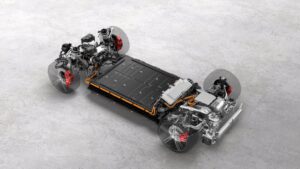Artificial intelligence (AI) has become an indispensable tool, especially for complex systems in a network, such as the battery-electric energy storage system.
The increasing number of highly developed sensors provides a volume of data that can no longer be processed with conventional software. For Porsche, using machine learning and AI for data analysis helps understand huge amounts of information and varying contexts, and provides reliable insights into component behavior and interaction.
AI in battery development
A high-voltage battery is a complex system that is exposed to a wide range of external and internal influences. Porsche’s engineers use data analysis and AI to establish these influences and their effects on the energy system.
AI supports developers in detecting implausible behavior within a battery. This allows the algorithms to analyze the balancing behavior of individual cells and the entire battery as early as the development stage. Balancing refers to the charge balance between the cells of a battery module. If the values deviate from the expected state, the data allows faster conclusions to be drawn about the causes and underlying processes. At the same time, the data quality in the development process is improved, so that later findings from customer vehicles are even more reliable.

In addition to the known main drivers of battery aging, modern analysis methods can also be used to identify other influences. Through the coupled application of state-of-the-art data-analysis methods and physicochemical models, forecasts and analyses of the aging of high-voltage batteries in the customer fleet can be created. Optimization criteria such as range, charging time, system performance, weight, durability and consumption are worked out.
Analyses based on AI must be understandable and explainable to provide a reliable foundation for development-related decision-making. Therefore, explainable AI methods are used. Porsche says that AI is a tool that helps the team to understand complex relationships and take all relevant aspects into account. In combination with the expertise of the sports car manufacturer’s development engineers, this enables a precise classification of the situation at the end of the analysis.
Through an intelligent and adapted system design, the aging influences identified by AI can be reduced in a targeted manner.
Preventative anomaly detection
A particularly innovative data analysis method, which is being used on data from the battery of the Porsche Macan, is preventive anomaly exploration. This assesses the technical cause and relevance should any anomalies be detected in the data.
Preventive anomaly detection uses detectors that use intelligent algorithms to extract, for example, a change in the behavior of the battery from the online data. The detected anomalies are analyzed, deciphered and evaluated in the cloud.
However, if a relevant anomaly should occur, Porsche proactively informs the driver with specific instructions via the MyPorsche app. This method can evaluate the data of each cell of the battery individually.
Preventive anomaly detection aims to use data-analysis methods to ensure the reliability and performance of vehicles, and to predict potential limitations.
In related news, Porsche Engineering has developed what it is calling a concept for an ‘AC battery’ which integrates the normally separate functions of the battery management system, inverter, low-voltage DCDC and onboard charger into one single component, controlled by a standardized control unit concept with a particularly powerful and real-time-capable computing platform. Read the full story here


